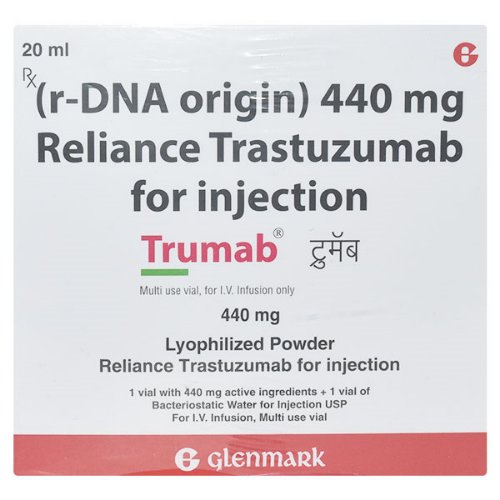Product Introduction:
Trumab is an anti-cancer medication classified as a HER2-targeted monoclonal antibody, developed by Reliance Life Sciences. It is a biosimilar of trastuzumab, widely used in the management of HER2-overexpressing breast and gastric cancers. Trumab is administered via intravenous infusion and offers an effective and often better-tolerated alternative to traditional chemotherapy for HER2-positive cancers.
Uses (Indications):
Trumab (Trastuzumab) is indicated for the treatment of the following conditions:
-
HER2-positive metastatic breast cancer
-
Early-stage HER2-positive breast cancer, as adjuvant therapy following surgery and chemotherapy
-
HER2-positive gastric or gastroesophageal junction adenocarcinoma in combination with chemotherapy
-
Neoadjuvant therapy in HER2-positive locally advanced breast cancer
-
Recurrent HER2-positive breast cancer (both locoregional and distant metastases)
-
Off-label in some HER2-amplified solid tumors (under clinical evaluation)
Storage Instructions:
-
Store the lyophilized vial at 2°C to 8°C (refrigerator)
-
Do not freeze the vials
-
Protect from light and moisture
-
Once reconstituted, the solution should be used immediately or stored at 2–8°C for up to 28 days (for 440 mg multidose)
-
Discard unused solution beyond the recommended storage duration
How It Works (Mechanism of Action):
Trastuzumab (Trumab) is a humanized IgG1 monoclonal antibody that targets the extracellular domain of the HER2/neu receptor.
Mechanism details:
-
Binds specifically to the HER2 receptor, overexpressed in ~20-25% of breast cancers
-
Inhibits receptor dimerization and downstream signaling (PI3K/Akt and MAPK pathways)
-
Promotes antibody-dependent cellular cytotoxicity (ADCC), directing immune cells to destroy tumor cells
-
Leads to cell cycle arrest, decreased proliferation, and apoptosis of HER2-positive cancer cells
This targeted action makes it especially effective in tumors dependent on HER2 signaling.
Side Effects:
Common Side Effects:
-
Fever, chills during infusion
-
Nausea, vomiting
-
Fatigue
-
Headache
-
Rash
-
Diarrhea
Serious Side Effects:
-
Cardiotoxicity – including congestive heart failure (especially when combined with anthracyclines)
-
Infusion-related reactions – fever, hypotension, bronchospasm, angioedema
-
Pulmonary toxicity – interstitial pneumonitis, acute respiratory distress
-
Hepatotoxicity – elevated liver enzymes
-
Anaphylaxis or hypersensitivity reactions
-
Myelosuppression – rare but may occur in combination regimens
Dosage (Typical Recommended Dose):
For Breast Cancer (IV formulation):
-
Loading dose:
-
4 mg/kg IV over 90 minutes
-
Maintenance dose:
-
2 mg/kg IV weekly (or 6 mg/kg every 3 weeks depending on the regimen)
-
Duration: Usually continued for 1 year in early breast cancer
For Gastric Cancer:
-
Loading dose: 8 mg/kg IV over 90 minutes
-
Maintenance dose: 6 mg/kg IV every 3 weeks
-
Continue until disease progression or unacceptable toxicity
Method of Administration:
-
Administered intravenously after reconstitution with sterile water
-
Initial loading dose over 90 minutes under medical supervision
-
If well tolerated, subsequent doses may be infused over 30 minutes
-
Must not be administered as an IV push or bolus
-
Observe the patient closely during and after the first infusion for infusion-related reactions
Precautions:
-
Baseline and periodic cardiac function monitoring (e.g., echocardiogram or MUGA scan) is essential
-
Avoid concurrent use with anthracyclines due to enhanced cardiotoxicity risk
-
Use caution in elderly patients or those with prior heart conditions
-
Discontinue temporarily or permanently if left ventricular ejection fraction (LVEF) declines significantly
-
Not recommended during pregnancy or lactation
-
Ensure HER2-positive status is confirmed by validated testing before starting treatment
Drug Interactions:
-
Anthracyclines (e.g., Doxorubicin): High risk of cardiotoxicity
-
Cyclophosphamide, Paclitaxel: Commonly used together but require close cardiac monitoring
-
No significant CYP450-mediated interactions, but concurrent cytotoxic chemotherapies may amplify side effects
-
Live vaccines should be avoided during and shortly after therapy
Allergies (Warnings for Allergic Reactions):
-
Contraindicated in patients with known hypersensitivity to trastuzumab, Chinese hamster ovary cell proteins, or any excipients
-
Watch for signs of anaphylaxis, angioedema, urticaria, or bronchospasm during infusion
-
Premedication with antipyretics and antihistamines may be considered in patients with prior mild infusion reactions
Overdose Information:
-
No specific antidote for trastuzumab overdose
-
In cases of overdose, monitor for signs of toxicity, especially cardiac function
-
Supportive and symptomatic care is essential
-
Infusion should be stopped immediately if any severe adverse event occurs
Missed Dose Instructions:
-
If a scheduled dose is missed, it should be administered as soon as possible
-
The interval between subsequent doses should be maintained as originally scheduled
-
If a delay exceeds one week, reloading may be required depending on treatment protocol
-
Always consult an oncologist for dose re-initiation planning
Additional Notes:
-
HER2 testing (IHC or FISH) is mandatory prior to initiating Trumab
-
Cardiotoxicity may be reversible upon discontinuation in most cases
-
Treatment is often combined with chemotherapy, endocrine therapy, or radiation depending on the stage
-
Patients should be monitored long-term for delayed cardiotoxicity, even after discontinuation
-
Trumab is a biosimilar – proven comparable to Herceptin in terms of safety, efficacy, and quality
-
Should only be administered under the supervision of an experienced oncologist



